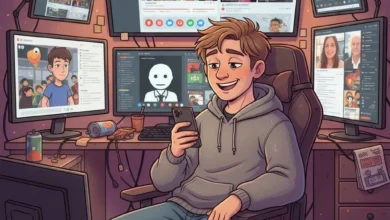Caricatronchi Explained: Origins, Symbolism, and Cultural Relevance

Have you ever come across the word caricatronchi and wondered what it really means? At first, it might sound unusual, almost invented, but that’s part of its intrigue. Words like this often carry history, layers of symbolism, and cultural resonance that extend far beyond their surface. Caricatronchi is one such term-a blend of artistic exaggeration, cultural expression, and evolving usage that has managed to remain relevant across generations.
In this article, we will dive deep into where caricatronchi comes from, how it has been used historically, and why it still matters today. Along the way, we’ll uncover its role in art, literature, and even modern digital culture. Think of this as an extended conversation-one that explains the concept clearly while keeping the discussion lively and engaging. By the end, you will not only know what caricatronchi is but also why it continues to spark curiosity in creative circles.
The Concept Caricatronchi Beyond Definition
Caricatronchi could simply be called a form of exaggeration. However, it does not explain much richness within. At the core, caricatronchi is the act of augmenting reality for the sake of reformulating it, incorporating an unmistakable measure of playfulness or critique. More than mere humor, it is commentary, statement, and oftentimes, a cultural form of storytelling.
That by itself defines caricature; typically, when one thinks of caricatures, it’s exaggerated faces in cartoons or perhaps as high-wire acts in satirical sketches. Caricatronchi follows the same logic, but it has gone further than pictorial art. Likewise, in one way or another, this has been generalizing the acts of how someone speaks, writes, or even behaves with details extended for an audience’s dramatic effect. Thus, this logic not only makes this a linguistic oddity but also makes it a cultural tool.
Historical and Cultural Origins of Caricatronchi in Human Expression
Caricatronchi has much to do with the human creativity tale. From ancient times, exaggeration became the main feature in performance, storytelling, and art. The communities largely depended on showing overblown gestures and Figuration characters in performance either in entertainment, pedagogy, or sometimes critiques of society.
Some linguists suggest that caricatronchi originates from margarink in the traditions that appreciated caricature as a form of expression. Its syllables echo words with humor and drama linked to some form of artistic distortion. Thus, through time, regional dialects helped form this unique and fleshed-out term culturally.
In some communities, caricatronchi referred to theatrical performances where the character’s features and actions were magnified by design, while in others, this was associated with drawing styles that mock or highlight social figures. Either way, the term has been short-hand for exaggeration as a cultural mirror, holding up life in a distorted picture to make truth easier to see.
Obstinate Relevance of Caricatronchi in Contemporary Times
Caricatronchi seems an archaic word. Yet, its importance hasn’t diminished. Instead, with the growth of creative industries and digital platforms, its meaning has been extended. Here are some aspects that guarantee its continued relevance in today’s world:
- A bridge between past and present: Caricatronchi keeps the tradition of exaggeration alive while fitting into modern contexts, such as social media.
- A means of expression: Impact is how writers, artists, and comedians use it to speak to their audience.
- Cultural communality: Shared humor, satire, or storytelling based on binds people.
- A sign of adaptability: Its power to shift across mediums-from drawings to memes-shows its timelessness.
- A muse for creating: By encouraging exaggeration inspires new ways of imagining and interpreting reality.
What adds the cherry on the cake when these points are concerned is the way every point does not represent an abstract idea but material.
Symbolism: Caricatronchi as Representation on Deeper Level
Caricatronchi embodies abstraction a translation of reality filtered through emotion and perception. It pulls expression away from literal accuracy and brings it closer to personal truth. Every distorted line and magnified feature becomes a reflection of how the artist negotiates with realism: not to replicate life, but to reinterpret it. Rather than pursuing precision, the goal is to capture an impression — sometimes humorous, sometimes unsettling, yet always unforgettable.
This symbolism resonates because exaggeration is inherently human. In every culture, storytelling thrives on amplification; we heighten drama, sharpen contrasts, and dim the lights to make moments glow brighter in memory. Caricatronchi mirrors that instinct, elevating exaggeration from mere distortion to an essential communicative force a way to reveal emotional reality beneath the surface of form. It reminds us that truth is not always found in accuracy, but often in the exaggerations that make meaning visible.
Caricotronchi as Different Art Forms
Literature
It is used by writers to make indelible characters. It is the him stretching behaviours or oddities along which they insert humour and character into their narratives.
Art and Illustration
In visual arts, caricatronchi sees caricature drawings, satirical portraits, and fun exaggerations. By this kind of style, it has attention and commentary delivery in one stroke.
Digital Media
Thus, in the present time, online platforms where speech has a natural home under the expression caricatronchi are memes, animated GIFs, and parody videos, all alive in exaggeration that continues to keep this word in the virtual culture.
Many Practical Uses of Caricatronchi in World Today
Surprisingly, the term manages to express a lot for something laden with historical depth. Designers use it to sketch expensive fashion or branding campaigns. Comedians push punchlines that land that much harder when reality is stretched. Storytellers rely on it when characterizing anything that can’t stand their ordinary standing.
Online, caricatronchi interacts daily. Here are memes blowing up daily frustrations, satirical posts that contort trivial events, and even advertisements taking a page from here, presenting products appealingly or exaggeratedly to grab attention.
It isn’t a past remnant; far from it is a living, fresh idea that establishes communication across industries and applications.
Caricatronchi as a Reflected Connection Among Humans
What makes caricatronchi so good? Because exaggeration is human. Emotional, one unboundedable relatability, and lively gives life to communication. When we laugh at a caricature or share an exaggerated meme with our audience, it shows that we are all involved in a collective understanding that to exaggerate is part of the way human beings connect.
In that sense, the aspect is not just about art or humor; it’s about belonging. It shows a common cultural language that transcends continents, as relevant today as it was when this term was first used.
As we explore how caricatronchi magnifies creative expression through exaggeration, it complements the philosophy of simplicity and clarity discussed in Living with simpciry. The Modern Path to Focus and Freedom”. Together, these ideas suggest a balance: you can express boldly and meaningfully while keeping your life uncluttered and intentional.
Conclusion
Caricatronchi is just that curious bit in language but more: a testament to man’s need for expression. Rooted in culture, it has evolved into a multi-faceted concept that thrives in literature, art, and comedy, as well as in digital media. Its enduring relevance is that it exaggerates reality while indeed revealing some truths in unexpected ways.
In the end it keeps reminding everyone that language is not static-the words travel, transform, and adapt, carrying stories, humor, and meaning that connect us across time and space. That’s why is interesting and worth remembering in a world where everything is all about expression.
FAQs
Q1: What does the word mean in simple words?
It means excessive distance in art, humor, or narrating wherein reality is pulled for impact.
Q2: Where did the term originate?
It grew from traditions of caricature, theater, and cultural storytelling that prized dramatization.
Q3: How is caricatronchi being utilized in modern culture?
Within art, comedy, digital memes, and branding, it serves as an instrument in expression.
Q4: What makes it important?
Because it bridges past traditions of exaggeration with present-day creative practice keeping culture alive.





